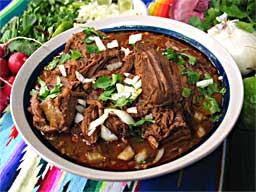Ceviche
Ceviche (also spelt cebiche or seviche) is a seafood dish popular in the coastal regions of the Americas, especially Central and South America.‚ The dish is typically made from fresh raw fish marinated in citrus juices such as lemon or lime and spiced with chilli peppers. Additional seasonings such as onion, salt, and pepper may also be added. Ceviche is usually accompanied by side dishes that complement its flavors such as sweet potato, lettuce, corn, or avocado.

Elote
Elote (Nahuatl: elotl or Quechua:choclo), which is the Mexican name for what would be called corn on the cob in English, boiled they are a popular street food in Mexico, although they can be and are frequently served as meal at home prepared in the same way. In Mexico, Chicago, and in the south of the United States, it is customary to consume elotes like a popsicle on a stick or by grasping the husk of the cob that has been pulled down to form a “handle”. Condiments such as salt, chili powder, butter, cheese, lemon juice, mayonnaise, and sour cream are usually put in the elote. Powdered lemon pepper seasoning is used on the elotes in Texas.

Fideo‚
In Mexican cuisine it is commonly used in soups. There are a wide variety of recipes, but the basic recipe calls for lightly browning the fideo in oil, then adding a base of chicken or beef broth, with pureed tomato, chile peppers, garlic, and onion.
Cilantro, beef, chicken, corn, or other ingredients may also be included. The mixture is then boiled until the fideo and other ingredients are cooked. When served it can be garnished with lime or lemon juice, chile or hot sauce, sour cream, and/or white Mexican cheese.
Refried Beans
Refried beans (frijoles refritos) is a dish of cooked and mashed beans and is a traditional staple of Mexican and Tex-Mex cuisine, although each cuisine has a somewhat different approach when making the dish.
In Northern Mexico and in American Tex-Mex cuisine, refried beans are usually prepared with pinto beans, but many other varieties of bean are used in other parts of Mexico, such as black or red beans. The raw beans can be cooked when dry or soaked overnight, then stewed, drained of most of the remaining liquid, and converted into a paste with a masher (such as a potato masher, or pressed through a fine mesh sieve (to remove the skins), or simply with a fork (or the back of a large flat spoon). Some of the drained liquid, or chicken or vegetable stock, is added if the consistency is too dry. The paste is then baked with lard or vegetable oil and seasoned to taste with salt and spices. For vegetarians, or in cases when lard is unavailable, it can be replaced with oil.

Guacamole
Guacamole is an avocado-based dip which originated in Mexico. It is traditionally made by mashing ripe avocados with a molcajete (pestle and mortar) with salt. Some recipes call for tomatoes, lime juice, coriander, garlic and seasonings.

Jcama
Jcama (pronounced /‹†h‰ªk‰m‰/, Spanish pronunciation: [‹†xikama], from Nahuatl xicamatl, [ŠÆ’i‹†kamat‰]), also Yam and Mexican Turnip, is the name of a native Mexican vine, although the name most commonly refers to the plant’s edible tuberous root. Jcama is one species in the genus Pachyrhizus. Plants in this genus are commonly referred to as yam bean, although the term “yam bean” can be another name for jcama. The other major species of yam beans are also indigenous within the Americas.

Nopalitos
Nopalitos is a dish made with diced nopales. They are sold fresh, bottled, or canned and less often dried. They have a light, slightly tart flavor, and a crisp, mucilaginous texture. Nopalitos are often eaten with eggs as a breakfast and in salads and soups as lunch and dinner meals. Nopalitos are low carbohydrate and may help in the treatment of diabetes.

Pambazo
Pambazo is the name of a Mexican white bread. It is also the name of the dish or antojito (very similar to the torta) made with this bread dipped in a red guajillo pepper sauce and filled with papas con chorizo (potatoes with chorizo).
The bread used for pambazos is white and lacks a crispy crust. This particular bread is made of flour, lard, eggs, and its tougher and dried than the similar bolillo (also used for sandwiches), which allows it to retain its shape while being soaked in sauce. Pambazos are usually found in Mexican bakeries where they are sold just as any other white bread. However, since its exterior surface is a bit dry and fragile, is usually reserved for other uses than a meals companion.

Pico de Gallo
In Mexican cuisine, pico de gallo (Spanish for “rooster’s beak”), also called salsa fresca, is a fresh, uncooked condiment made from chopped tomato, onion, and sometimes chilis (typically jalape±os or serranos). Other ingredients may also be added, such as lemon or lime juice, fresh cilantro (coriander leaf), cucumber, radish or other fresh firm pulpy fruit such as mango.
Pico de gallo can be used in much the same way as other Mexican salsas, or Indian chutneys, but since it contains less liquid, it can also be used as a main ingredient in dishes such as tacos and fajitas.

Salsa
Salsa may refer to any type of sauce. In American English, it usually refers to the spicy, often tomato based, hot sauces typical of Mexican and Central American cuisine, particularly those used as dips. In British English, the word typically refers to salsa cruda, which is common in Mexican, Spanish and Italian cuisine.
Mexican salsas were traditionally produced using the mortar and pestle-like molcajete, although blenders are now more commonly used. The Mayans made salsa also, using a mortar and pestle. They made what we now call guacamole.

Tortilla
Tortilla Mexican Spanish: [tor‹†tiŠa]; English: /t‰r‹†ti‹.‰/) means “little cake” in Spanish, and refers to several different foods eaten in various Spanish speaking countries and parts of the United States. In Mexico, Central America, as well as in English, “tortilla” refers to a flatbread made from corn or wheat originally made by Mesoamerican peoples. In Spain, South America, Cuba, and Puerto Rico, “tortilla” refers to an omelette, with variations that can include vegetables such as onions and potatoes.

Totopos
Totopos, in Mexican cuisine, are a flat, round, or triangular corn product similar to a tortilla best known as originating from Zapotec peoples of the isthmus of Tehuantepec region of the Mexican state of Oaxaca. There, the Zapotec women bake totopos in a clay oven known as a comixcal. Totopos resemble a round, baked tortilla chip or certain types of Scandinavian flat bread, however, unlike tortillas, salt is added to the masa and holes are made in the disk prior to baking.

Albóndigas
In Spain and Latin America, meatballs are called “albóndigas”, derived from the Arabic ‘al-bunduq’ (meaning ‘hazelnut,’ or, by extension, a small round object). Albóndigas are thought to have originated as a Berber or Arab dish imported to Spain during the period of Muslim rule.
Spanish albóndigas can be served as an appetizer or main course, often in a tomato sauce, while Mexican albóndigas are commonly served in a soup with a light broth and vegetables.

Birria
Birria (pronounced brria, accented on the first syllable) is a spicy Mexican meat stew usually made with goat, lamb, or mutton, often served during festive periods, such as Christmas, New Year’s Eve, Mother’s Day, and weddings. Originally from Jalisco, it is a common dish in some Mexican food establishments. It is served with corn tortillas, onion, cilantro, and lime.
Birria is made using a base of dried roasted peppers. This gives birria both its characteristic savoriness as well as its remarkable variety, as different cooks will choose different peppers to use for the broth base. Birria is served by combining a bowl of broth with freshly chopped roasted meat of the customer’s choice.

Burrito
A burrito (pronounced /b‰‹†ri‹toŠ / in US English, [bu‹†rito] in Spanish), or taco de harina, is a type of Mexican food. It consists of a flour tortilla wrapped or folded around a filling. The flour tortilla is usually lightly grilled or steamed, to soften it and make it more pliable. In Mexico, refried beans, Mexican rice, or meat are usually the only fillings and the tortilla is smaller in size. In the United States, however, fillings generally include a combination of ingredients such as Mexican rice, beans, lettuce, salsa, meat, avocado, cheese, and sour cream, and the size varies, with some burritos considerably larger than their Mexican counterparts.

Carnitas
Carnitas, literally “little meats”, is a type of braised or roasted (often after first being simmered) pork in Mexican cuisine.
The carnitas of Sahuayo, Michoacán, are internationally well-known; they are served accompanied with chopped coriander leaves (cilantro) and diced onion, salsa, guacamole, tortillas, refried beans (frijoles refritos), lime and radishes. Specific cuts of the carnitas (for example, ribs, skin, or various organ meats) can be requested.‚ It can be a dish by itself, or as an ingredient in tamales, tacos, tortas, and burritos.

Cecina
In Spanish, cecina means “meat that has been salted and dried by means of air, sun or smoke”. The word comes either from the Latin siccus (dry) or from the celtic ciercina related to modern Spanish “cierzo” or Northern wind. The word cecina is also used to name other kinds of dried or cured meat in Latin America. In Mexico, most cecina is of two kinds: sheets of beef that are marinated and a pork kind that is pounded thin and coated with chili pepper (this type is called cecina enchilada, or carne enchilada). The beef version is salted and marinated and laid to dry somewhat in the sun. The town of Yecapixtla is well known for its version of the dish which varies from region to region.

Chimichanga
Chimichanga (pronounced /tŠÆ’‰ªmi‹†tŠÆ’…‰á‰/; Spanish: [tŠÆ’imi‹†tŠÆ’a…‰áa]), or chivichanga, is a deep-fried burrito that is popular in Southwestern cuisine, Tex-Mex cuisine, and the Mexican states of Sinaloa and Sonora. The dish is typically prepared by filling a flour tortilla with a wide range of ingredients, most commonly beans, rice, cheese, shredded beef, carne adobada, or shredded chicken, and folding it into a rectangular package. It is then deep-fried and can be accompanied with salsa, guacamole, sour cream and/or cheese.

Empanada
An empanada is a Spanish and Portuguese stuffed bread or pastry. The name comes from the verb empanar, meaning to wrap or coat in bread. Empanada is made by folding a dough or bread patty around the stuffing. The stuffing can consist of many things such as meat or vegetables. In Spain, empanadas are usually large and circular in shape and are cut into smaller portions for consumption, whereas in Portugal and South America empanadas are normally small and semi-circular (this type of empanada is commonly known as empanadilla in Spain). Empanadas are also known by a wide variety of regional names (see the entries for the individual countries below).


